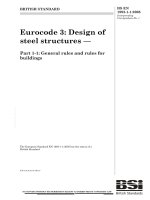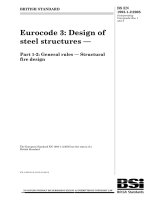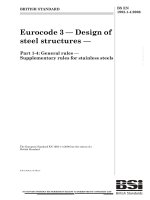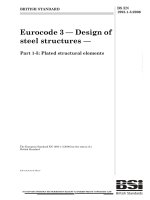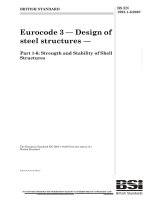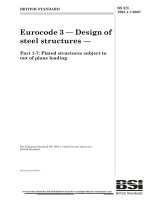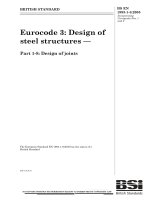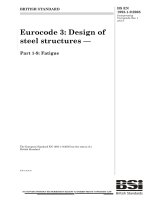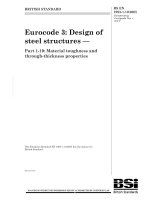Tiêu chuẩn Châu Âu EC8: Kết cấu chống động đất phần 4: Bể chúa, ống dẫn (Eurocode8 BS EN1998 4 e 2006 Design of structure for earthquake resistance part 4:Silos, tanks and pipelines)
Bạn đang xem bản rút gọn của tài liệu. Xem và tải ngay bản đầy đủ của tài liệu tại đây (1.29 MB, 84 trang )
BRITISH STANDARD
Eurocode 8:
Design of structures
for earthquake
resistance —
Part 4: Silos, tanks and pipelines
The European Standard EN 1998-4:2006 has the status of a British
Standard
ICS 91.120.25
12 &23<,1* :,7+287 %6, 3(50,66,21 (;&(37 $6 3(50,77(' %< &23<5,*+7 /$:
BS EN
1998-4:2006
BS EN 1998-4:2006
National foreword
This British Standard was published by BSI. It is the UK implementation of
EN 1998-4:2006. It supersedes DD ENV 1998-4:1999 which is withdrawn.
The UK participation in its preparation was entrusted by Technical Committee
B/525, Building and civil engineering structures, to Subcommittee B/525/8,
Structures in seismic regions.
A list of organizations represented on B/525/8 can be obtained on request to its
secretary.
This publication does not purport to include all the necessary provisions of a
contract. Users are responsible for its correct application.
Compliance with a British Standard cannot confer immunity from
legal obligations.
This British Standard was
published under the authority
of the Standards Policy and
Strategy Committee
on 29 September 2006
© BSI 2006
ISBN 0 580 49272 9
Amendments issued since publication
Amd. No.
Date
Comments
EUROPEAN STANDARD
EN 1998-4
NORME EUROPÉENNE
EUROPÄISCHE NORM
July 2006
ICS 91.120.25
Supersedes ENV 1998-4:1998
English Version
Eurocode 8 - Design of structures for earthquake resistance Part 4: Silos, tanks and pipelines
Eurocode 8 - Calcul des structures pour leur résistance aux
séismes - Partie 4: Silos, réservoirs et canalisations
Eurocode 8 - Auslegung von Bauwerken gegen Erdbeben Teil 4: Silos, Tankbauwerke und Rohrleitungen
This European Standard was approved by CEN on 15 May 2006.
CEN members are bound to comply with the CEN/CENELEC Internal Regulations which stipulate the conditions for giving this European
Standard the status of a national standard without any alteration. Up-to-date lists and bibliographical references concerning such national
standards may be obtained on application to the Central Secretariat or to any CEN member.
This European Standard exists in three official versions (English, French, German). A version in any other language made by translation
under the responsibility of a CEN member into its own language and notified to the Central Secretariat has the same status as the official
versions.
CEN members are the national standards bodies of Austria, Belgium, Cyprus, Czech Republic, Denmark, Estonia, Finland, France,
Germany, Greece, Hungary, Iceland, Ireland, Italy, Latvia, Lithuania, Luxembourg, Malta, Netherlands, Norway, Poland, Portugal, Romania,
Slovakia, Slovenia, Spain, Sweden, Switzerland and United Kingdom.
EUROPEAN COMMITTEE FOR STANDARDIZATION
COMITÉ EUROPÉEN DE NORMALISATION
EUROPÄISCHES KOMITEE FÜR NORMUNG
Management Centre: rue de Stassart, 36
© 2006 CEN
All rights of exploitation in any form and by any means reserved
worldwide for CEN national Members.
B-1050 Brussels
Ref. No. EN 1998-4:2006: E
EN 1998-4:2006 (E)
Contents
FOREWORD
1
GENERAL ........................................................................................................................................ 8
1.1
1.2
1.2.1
1.3
1.4
1.5
1.5.1
1.5.2
1.5.3
1.5.4
1.6
1.7
2
SCOPE ........................................................................................................................................ 8
NORMATIVE REFERENCES .......................................................................................................... 9
General reference standards ................................................................................................ 9
ASSUMPTIONS .......................................................................................................................... 10
DISTINCTION BETWEEN PRINCIPLES AND APPLICATIONS RULES ............................................... 10
TERMS AND DEFINITIONS ......................................................................................................... 10
General............................................................................................................................... 10
Terms common to all Eurocodes ........................................................................................ 10
Further terms used in EN 1998 .......................................................................................... 10
Further terms used in EN 1998-4....................................................................................... 10
SYMBOLS ................................................................................................................................. 10
S.I. UNITS ................................................................................................................................ 11
GENERAL PRINCIPLES AND APPLICATION RULES......................................................... 13
2.1
SAFETY REQUIREMENTS ........................................................................................................... 13
2.1.1
General............................................................................................................................... 13
2.1.2
Ultimate limit state ............................................................................................................. 13
2.1.3
Damage limitation state ..................................................................................................... 14
2.1.4
Reliability differentiation ................................................................................................... 15
2.1.5
System versus element reliability........................................................................................ 16
2.1.6
Conceptual design .............................................................................................................. 16
2.2
SEISMIC ACTION ....................................................................................................................... 17
2.3
ANALYSIS ................................................................................................................................ 17
2.3.1
Methods of analysis ............................................................................................................ 17
2.3.2
Interaction with the soil...................................................................................................... 18
2.3.3
Damping ............................................................................................................................. 19
2.3.3.1
2.3.3.2
2.3.3.3
2.3.3.4
Structural damping ..................................................................................................................19
Contents damping....................................................................................................................19
Foundation damping ................................................................................................................19
Weighted damping...................................................................................................................19
2.4
BEHAVIOUR FACTORS .............................................................................................................. 19
2.5
SAFETY VERIFICATIONS ........................................................................................................... 20
2.5.1
General............................................................................................................................... 20
2.5.2
Combinations of seismic action with other actions ............................................................ 20
3
SPECIFIC PRINCIPLES AND APPLICATION RULES FOR SILOS.................................... 22
3.1
3.2
3.3
3.4
3.5
3.5.1
3.5.2
INTRODUCTION ........................................................................................................................ 22
COMBINATION OF GROUND MOTION COMPONENTS .................................................................. 22
ANALYSIS OF SILOS .................................................................................................................. 23
BEHAVIOUR FACTORS .............................................................................................................. 25
VERIFICATIONS ........................................................................................................................ 26
Damage limitation state ..................................................................................................... 26
Ultimate limit state ............................................................................................................. 26
3.5.2.1
3.5.2.2
3.5.2.3
3.5.2.4
4
Global stability ........................................................................................................................26
Shell.........................................................................................................................................26
Anchors ...................................................................................................................................27
Foundations .............................................................................................................................27
SPECIFIC PRINCIPLES AND APPLICATION RULES FOR TANKS.................................. 28
4.1
COMPLIANCE CRITERIA ............................................................................................................ 28
4.1.1
General............................................................................................................................... 28
4.1.2
Damage limitation state ..................................................................................................... 28
4.1.3
Ultimate limit state ............................................................................................................. 28
4.2
COMBINATION OF GROUND MOTION COMPONENTS .................................................................. 29
2
EN 1998-4:2006 (E)
4.3
METHODS OF ANALYSIS ........................................................................................................... 29
4.3.1
General............................................................................................................................... 29
4.3.2
Hydrodynamic effects ......................................................................................................... 29
4.4
BEHAVIOUR FACTORS .............................................................................................................. 30
4.5
VERIFICATIONS ........................................................................................................................ 31
4.5.1
Damage limitation state ..................................................................................................... 31
4.5.1.1
4.5.1.2
4.5.1.3
4.5.2
General ....................................................................................................................................31
Shell.........................................................................................................................................31
Piping ......................................................................................................................................31
Ultimate limit state ............................................................................................................. 31
4.5.2.1
4.5.2.2
4.5.2.3
4.5.2.4
4.5.2.5
Stability ...................................................................................................................................31
Shell.........................................................................................................................................31
Piping ......................................................................................................................................32
Anchorages..............................................................................................................................32
Foundations .............................................................................................................................32
4.6
COMPLEMENTARY MEASURES .................................................................................................. 32
4.6.1
Bunding .............................................................................................................................. 32
4.6.2
Sloshing .............................................................................................................................. 33
4.6.3
Piping interaction............................................................................................................... 33
5
SPECIFIC PRINCIPLES AND APPLICATION RULES FOR ABOVE-GROUND PIPELINES
34
5.1
5.2
5.2.1
5.2.2
5.3
5.3.1
5.3.2
5.3.3
5.4
5.4.1
5.4.2
5.5
5.6
6
GENERAL ................................................................................................................................. 34
SAFETY REQUIREMENTS ........................................................................................................... 34
Damage limitation state ..................................................................................................... 34
Ultimate limit state ............................................................................................................. 35
SEISMIC ACTION ....................................................................................................................... 35
General............................................................................................................................... 35
Seismic action for inertia movements................................................................................. 35
Differential movement ........................................................................................................ 35
METHODS OF ANALYSIS ........................................................................................................... 35
Modelling ........................................................................................................................... 36
Analysis .............................................................................................................................. 36
BEHAVIOUR FACTORS .............................................................................................................. 36
VERIFICATIONS ........................................................................................................................ 37
SPECIFIC PRINCIPLES AND APPLICATION RULES FOR BURIED PIPELINES .......... 38
6.1
6.2
6.2.1
6.2.2
6.3
6.3.1
6.3.2
6.3.3
6.3.4
6.4
6.5
6.5.1
6.5.2
6.5.3
6.6
GENERAL ................................................................................................................................. 38
SAFETY REQUIREMENTS ........................................................................................................... 38
Damage limitation state ..................................................................................................... 38
Ultimate limit state ............................................................................................................. 38
SEISMIC ACTION ....................................................................................................................... 38
General............................................................................................................................... 38
Seismic action for inertia movements................................................................................. 39
Modelling of seismic waves ................................................................................................ 39
Permanent soil movements ................................................................................................. 39
METHODS OF ANALYSIS (WAVE PASSAGE) ............................................................................... 40
VERIFICATIONS ........................................................................................................................ 40
General............................................................................................................................... 40
Buried pipelines on stable soil ........................................................................................... 40
Buried pipelines under differential ground movements (welded steel pipes) ..................... 41
DESIGN MEASURES FOR FAULT CROSSINGS .............................................................................. 41
ANNEX A (INFORMATIVE)................................................................................................................. 43
SEISMIC ANALYSIS PROCEDURES FOR TANKS ......................................................................... 43
ANNEX B (INFORMATIVE) ................................................................................................................. 79
BURIED PIPELINES .............................................................................................................................. 79
3
EN 1998-4:2006 (E)
Foreword
This European Standard EN 1998-4, Eurocode 8: Design of structures for earthquake
resistance: Silos, tanks and pipelines, has been prepared by Technical Committee CEN/TC
250 "Structural Eurocodes", the secretariat of which is held by BSI. CEN/TC 250 is
responsible for all Structural Eurocodes.
This European Standard shall be given the status of a National Standard, either by publication
of an identical text or by endorsement, at the latest by January 2007, and conflicting national
standards shall be withdrawn at latest by March 2010.
This document supersedes ENV 1998-4: 1997.
According to the CEN-CENELEC Internal Regulations, the National Standard Organizations
of the following countries are bound to implement this European Standard: Austria, Belgium,
Cyprus, Czech Republic, Denmark, Estonia, Finland, France, Germany, Greece, Hungary,
Iceland, Ireland, Italy, Latvia, Lithuania, Luxembourg, Malta, Netherlands, Norway, Poland,
Portugal, Slovakia, Slovenia, Spain, Sweden, Switzerland and United Kingdom.
Background of the Eurocode programme
In 1975, the Commission of the European Community decided on an action programme in the
field of construction, based on article 95 of the Treaty. The objective of the programme was
the elimination of technical obstacles to trade and the harmonization of technical
specifications.
Within this action programme, the Commission took the initiative to establish a set of
harmonized technical rules for the design of construction works which, in a first stage, would
serve as an alternative to the national rules in force in the Member States and, ultimately,
would replace them.
For fifteen years, the Commission, with the help of a Steering Committee with
Representatives of Member States, conducted the development of the Eurocodes programme,
which led to the first generation of European codes in the 1980’s.
In 1989, the Commission and the Member States of the EU and EFTA decided, on the basis of
an agreement 1 between the Commission and CEN, to transfer the preparation and the
publication of the Eurocodes to CEN through a series of Mandates, in order to provide them
with a future status of European Standard (EN). This links de facto the Eurocodes with the
provisions of all the Council’s Directives and/or Commission’s Decisions dealing with
European standards (e.g. the Council Directive 89/106/EEC on construction products - CPD and Council Directives 93/37/EEC, 92/50/EEC and 89/440/EEC on public works and services
and equivalent EFTA Directives initiated in pursuit of setting up the internal market).
The Structural Eurocode programme comprises the following standards generally consisting
of a number of Parts:
1
Agreement between the Commission of the European Communities and the European Committee for
Standardization (CEN) concerning the work on EUROCODES for the design of building and civil engineering
works (BC/CEN/03/89).
4
EN 1998-4:2006 (E)
EN 1990 Eurocode:
Basis of structural design
EN 1991 Eurocode 1: Actions on structures
EN 1992 Eurocode 2: Design of concrete structures
EN 1993 Eurocode 3: Design of steel structures
EN 1994 Eurocode 4: Design of composite steel and concrete structures
EN 1995 Eurocode 5: Design of timber structures
EN 1996 Eurocode 6: Design of masonry structures
EN 1997 Eurocode 7: Geotechnical design
EN 1998 Eurocode 8: Design of structures for earthquake resistance
EN 1999 Eurocode 9: Design of aluminium structures
Eurocode standards recognize the responsibility of regulatory authorities in each Member
State and have safeguarded their right to determine values related to regulatory safety matters
at national level where these continue to vary from State to State.
Status and field of application of Eurocodes
The Member States of the EU and EFTA recognize that Eurocodes serve as reference
documents for the following purposes:
–
as a means to prove compliance of building and civil engineering works with the essential
requirements of Council Directive 89/106/EEC, particularly Essential Requirement N°1 Mechanical resistance and stability - and Essential Requirement N°2 - Safety in case of
fire;
–
as a basis for specifying contracts for construction works and related engineering services;
–
as a framework for drawing up harmonized technical specifications for construction
products (ENs and ETAs)
The Eurocodes, as far as they concern the construction works themselves, have a direct
relationship with the Interpretative Documents 2 referred to in Article 12 of the CPD, although
they are of a different nature from harmonized product standards 3 . Therefore, technical
2
According to Art. 3.3 of the CPD, the essential requirements (ERs) shall be given concrete form in
interpretative documents for the creation of the necessary links between the essential requirements and the
mandates for hENs and ETAGs/ETAs.
3
According to Art. 12 of the CPD the interpretative documents shall :
a) give concrete form to the essential requirements by harmonising the terminology and the technical bases and
indicating classes or levels for each requirement where necessary ;
b) indicate methods of correlating these classes or levels of requirement with the technical specifications, e.g.
methods of calculation and of proof, technical rules for project design, etB. ;
c) serve as a reference for the establishment of harmonised standards and guidelines for European technical
approvals.
The Eurocodes, de facto, play a similar role in the field of the ER 1 and a part of ER 2.
5
EN 1998-4:2006 (E)
aspects arising from the Eurocodes work need to be adequately considered by CEN Technical
Committees and/or EOTA Working Groups working on product standards with a view to
achieving a full compatibility of these technical specifications with the Eurocodes.
The Eurocode standards provide common structural design rules for everyday use for the
design of whole structures and component products of both a traditional and an innovative
nature. Unusual forms of construction or design conditions are not specifically covered and
additional expert consideration will be required by the designer in such cases.
National Standards implementing Eurocodes
The National Standards implementing Eurocodes will comprise the full text of the Eurocode
(including any annexes), as published by CEN, which may be preceded by a National title
page and National foreword, and may be followed by a National annex (informative).
The National annex may only contain information on those parameters which are left open in
the Eurocode for national choice, known as Nationally Determined Parameters, to be used for
the design of buildings and civil engineering works to be constructed in the country
concerned, i.e. :
–
values and/or classes where alternatives are given in the Eurocode,
–
values to be used where a symbol only is given in the Eurocode,
–
country specific data (geographical, climatic, etc.), e.g. snow map,
–
the procedure to be used where alternative procedures are given in the Eurocode.
It may also contain
–
decisions on the application of informative annexes,
–
references to non-contradictory complementary information to assist the user to apply the
Eurocode.
Links between Eurocodes and harmonized technical specifications (ENs and ETAs) for
products
There is a need for consistency between the harmonized technical specifications for
construction products and the technical rules for works 4 . Furthermore, all the information
accompanying the CE Marking of the construction products which refer to Eurocodes shall
clearly mention which Nationally Determined Parameters have been taken into account.
Additional information specific to EN 1998-4
The scope of EN 1998 is defined in 1.1.1 of EN 1998-1: 2004. The scope of this Part of EN
1998 is defined in 1.1. Additional Parts of Eurocode 8 are listed in EN 1998-1: 2004, 1.1.3.
4
See Art.3.3 and Art.12 of the CPD, as well as clauses 4.2, 4.3.1, 4.3.2 and 5.2 of ID 1.
6
EN 1998-4:2006 (E)
EN 1998-4:2006 is intended for use by:
–
clients (e.g. for the formulation of their specific requirements on reliability levels and
durability) ;
–
designers and constructors ;
–
relevant authorities.
For the design of structures in seismic regions the provisions of this European Standard are to
be applied in addition to the provisions of the other relevant parts of Eurocode 8 and the other
relevant Eurocodes. In particular, the provisions of this European Standard complement those
of EN 1991-4, EN 1992-3, EN 1993-4-1, EN 1993-4-2 and EN 1993-4-3, which do not cover
the special requirements of seismic design.
National annex for EN 1998-4
This standard gives alternative procedures, values and recommendations for classes with notes
indicating where national choices may have to be made. Therefore the National Standard
implementing EN 1998-4 should have a National Annex containing all Nationally Determined
Parameters to be used for the design of buildings and civil engineering works to be
constructed in the relevant country.
National choice is allowed in EN 1998-4:2006 through clauses:
Reference
1.1(4)
2.1.2(4)P
2.1.3(5)P
2.1.4(8)
2.2(3)
2.3.3.3(2)P
2.5.2(3)P
3.1(2)P
4.5.1.3(3)
4.5.2.3(2)P
Item
Additional requirements for facilities associated with large risks to the
population or the environment.
Reference return period TNCR of seismic action for the ultimate limit
state (or, equivalently, reference probability of exceedance in 50 years,
PNCR).
Reference return period TDLR of seismic action for the damage limitation
state (or, equivalently, reference probability of exceedance in 10 years,
PDLR).
Importance factors for silos, tanks and pipelines
Reduction factor ν for the effects of the seismic action relevant to the
damage limitation state
Maximum value of radiation damping for soil structure interaction
analysis, ξmax
Values of ϕ for silos, tanks and pipelines
Unit weight of the particulate solid in silos, γ, in the seismic design
situation
Amplification factor on forces transmitted by the piping to region of
attachment on the tank wall, for the design of the region to remain
elastic in the damage limitation state
Overstrength factor on design resistance of piping in the verification
that the connection of the piping to the tank will not yield prior to the
piping in the ultimate limit state
7
EN 1998-4:2006 (E)
1
GENERAL
1.1
Scope
(1)
The scope of Eurocode 8 is defined in EN 1998-1: 2004, 1.1.1 and the scope of this
Standard is defined in this clause. Additional parts of Eurocode 8 are indicated in EN 1998-1:
2004, 1.1.3.
(2)
This standard specifies principles and application rules for the seismic design of the
structural aspects of facilities composed of above-ground and buried pipeline systems and of
storage tanks of different types and uses, as well as for independent items, such as for
example single water towers serving a specific purpose or groups of silos enclosing granular
materials, etc.
(3)
This standard includes the additional criteria and rules required for the seismic design
of these structures without restrictions on their size, structural types and other functional
characteristics. For some types of tanks and silos, it also provides detailed methods of
assessment and verification rules.
(4)
This standard may not be complete for those facilities associated with large risks to the
population or the environment, for which additional requirements are the responsibility of the
competent authorities. This standard is also not complete for those construction works which
have uncommon structural elements and which require special measures to be taken and
special studies to be performed to ensure earthquake protection. In those two cases the present
standard gives general principles but not detailed application rules.
NOTE The National Annex may specify additional requirements for facilities associated with large risks
to the population or the environment.
(5)
Although large diameter pipelines are within the scope of this standard, the
corresponding design criteria do not apply for apparently similar facilities, like tunnels and
large underground cavities.
(6)
The nature of lifeline systems which often characterizes the facilities covered by this
standard requires concepts, models and methods that may differ substantially from those in
current use for more common structural types. Furthermore, the response and the stability of
silos and tanks subjected to strong seismic actions may involve rather complex interaction
phenomena between soil-structure and stored material (either fluid or granular), not easily
amenable to simplified design procedures. Equally challenging may prove to be the design of
a pipeline system through areas with poor and possibly unstable soils. For the reasons given
above, the organization of this standard is to some extent different from that of other Parts of
EN 1998. This standard is, in general, restricted to basic principles and methodological
approaches.
NOTE Detailed analysis procedures going beyond basic principles and methodological approaches are
given in Annexes A and B for a number of typical situations.
(7)
In the formulation and implementation of the general requirements, a distinction has
been made between independent structures and redundant systems, via the choice of
importance factors and/or through the definition of specific verification criteria.
8
EN 1998-4:2006 (E)
(8)
If seismic protection of above-ground pipelines is provided through seismic isolation
devices between the pipeline and its supports (notably on piles), EN 1998-2:2005 applies, as
relevant. For the design of tanks, silos, or individual facilities or components of pipeline
systems with seismic isolation, the relevant provisions of EN 1998-1:2004 apply.
1.2
Normative references
(1)P This European Standard incorporates by dated or undated reference, provisions from
other publications. These normative references are cited at the appropriate places in the text
and the publications are listed hereafter. For dated references, subsequent amendments to or
revisions of any of these publications apply to this European Standard only when incorporated
in it by amendment or revision. For undated references the latest edition of the publication
referred to applies (including amendments).
1.2.1
General reference standards
EN 1990: 2002
Eurocode - Basis of structural design.
EN 1991-4: 2006
Eurocode 1 - Actions on structures – Part 4: Silos and tanks.
EN 1992-1-1: 2004 Eurocode 2 - Design of concrete structures – Part 1-1: General rules
and rules for buildings.
EN 1992-3: 2006
Eurocode 2 - Design of concrete structures – Part 3: Liquid retaining
and containing structures.
EN 1993-1-1: 2004 Eurocode 3 - Design of steel structures – Part 1-1: General rules and
rules for buildings.
EN 1993-1-5: 2006 Eurocode 3 - Design of steel structures – Part 1-5: Plated structural
elements.
EN 1993-1-6: 2006 Eurocode 3 - Design of steel structures – Part 1-6: Strength and
stability of shell structures.
EN 1993-1-7: 2006 Eurocode 3 - Design of steel structures – Part 1-7: Strength and
stability of planar plated structures transversely loaded.
EN 1993-4-1: 2006
Eurocode 3 - Design of steel structures – Part 4-1: Silos.
EN 1993-4-2: 2006
Eurocode 3 - Design of steel structures – Part 4-2: Tanks.
EN 1993-4-3: 2006
Eurocode 3 - Design of steel structures – Part 4-3: Pipelines.
EN 1997-1 : 2004
Eurocode 7 - Geotechnical design – Part 1: General rules.
EN 1998-1 : 2004
Eurocode 8 - Design of structures for earthquake resistance – Part 1:
General rules, seismic actions and rules for buildings.
EN 1998-2 : 2005
Eurocode 8 - Design of structures for earthquake resistance – Part 2:
Bridges.
9
EN 1998-4:2006 (E)
EN 1998-5 : 2004
Eurocode 8 - Design of structures for earthquake resistance – Part 5:
Foundations, retaining structures and geotechnical aspects.
EN 1998-6 : 2005
Eurocode 8 - Design of structures for earthquake resistance – Part 6:
Towers, masts and chimneys.
1.3
(1)P
1.4
Assumptions
The general assumptions shall be in accordance with EN 1990: 2002, 1.3.
Distinction between principles and applications rules
(1)P The distinction between principles and applications rules shall be in accordance with
EN 1990: 2002, 1.4.
1.5
Terms and Definitions
1.5.1
General
(1)
For the purposes of this standard the following definitions apply.
1.5.2
Terms common to all Eurocodes
(1)P
The terms and definitions given in EN 1990: 2002, 1.5 apply.
(2)P
EN 1998-1: 2004, 1.5.1 applies for terms common to all Eurocodes.
1.5.3
Further terms used in EN 1998
(1)
For the purposes of this European Standard the terms given in EN 1998-1: 2004, 1.5.1
and 1.5.2 apply.
1.5.4
Further terms used in EN 1998-4
Independent structure:
a structure whose structural and functional behaviour during and after a seismic event are not
influenced by that of other structures, and whose consequences of failure relate only to the
functions demanded from it.
1.6
(1)
Symbols
For the purposes of this European Standard the following symbols apply:
AEd
design value of seismic action ( = γIAEk)
AEk
characteristic value of the seismic action for the reference return period
b
horizontal dimension of silo parallel to the horizontal component of the seismic action
dc
inside diameter of a circular silo
dg
design ground displacement, as given in EN 1998-1:2004, 3.2.2.4(1), used in expression
(4.1)
10
EN 1998-4:2006 (E)
g
acceleration of gravity
hb
overall height of the silo, from a flat bottom or the hopper outlet to the equivalent
surface of the stored contents
q
behaviour factor
r
radius of circular silo, silo compartment, tank or pipe
rs *
geometric quantity defined in silos through expression (3.5) as rs* = min(H, Brs/2)
t
thickness
x
vertical distance of a point on a silo wall from a flat silo bottom or the apex of a conical
or pyramidal hopper
x
distance between the anchoring point of piping and the point of connection with the tank
z
vertical downward co-ordinate in a silo, measured from the equivalent surface of the
stored contents
α(z) ratio of the response acceleration of a silo at the level of interest, z, to the acceleration of
gravity
β
angle of inclination of the hopper wall in a silo, measured from the vertical, or the
steepest angle of inclination to the vertical of the wall in a pyramidal hopper
γ
bulk unit weight of particulate material in silo, taken equal to the upper characteristic
value given in EN 1991-4:2006, Table E1.
γI
importance factor
γp
amplification factor on forces transmitted by the piping to region of attachment on tank
wall, for the region to be designed to remain elastic, see 4.5.1.3(3)
Δ
minimum value of imposed relative displacement between the first anchoring point of
piping and the tank to be taken from given by expression (4.1)
Δph,s additional normal pressure on the silo wall due to the response of the particulate solid to
the horizontal component of the seismic action
Δph,so reference pressure on silo walls given in 3.3(8), expression (3.6)
θ
angle (0o ≤θ < 360o) between the radial line to the point of interest on the wall of a
circular silo and the direction of the horizontal component of the seismic action.
λ
the correction factor on base shear from the lateral force method of analysis, in EN
1998-1: 2004, 4.3.3.2.2(1).
ν
reduction factor for the effects of the seismic action relevant to the damage limitation
state
ξ
viscous damping ratio (in percent)
ψ2,i combination coefficient for the quasi-permanent value of a variable action i
ψE,i combination coefficient for a variable action i, to be used when determining the effects
of the design seismic action
1.7
S.I. Units
11
EN 1998-4:2006 (E)
(1)P
S.I. Units shall be used in accordance with ISO 1000.
(2)
In
12
addition,
the
units
recommended
in
EN
1998-1:2004,
1.7
apply.
EN 1998-4:2006 (E)
2
GENERAL PRINCIPLES AND APPLICATION RULES
2.1
Safety requirements
2.1.1
General
(1)P
This standard deals with structures which may differ widely in such basic features as:
–
the nature and amount of the contents and associated potential danger
–
the functional requirements during and after the seismic event
–
the environmental conditions.
(2)
Depending on the specific combination of the indicated features, different
formulations of the general requirements are appropriate. For the sake of consistency with the
general framework of the Eurocodes, the two-limit-states format is retained, with a suitably
adjusted definition.
2.1.2
Ultimate limit state
(1)P The ultimate limit state for which a system shall be checked is defined as that
corresponding to structural failure. In some circumstances, partial recovery of the operational
capacity of the system lost by exceedance of the ultimate limit state may be possible, after an
acceptable amount of repairs.
NOTE 1: The circumstances are those defined by the responsible authority or the client.
(2)P For particular elements of the network, as well as for independent structures whose
complete collapse would entail severe consequences, the ultimate limit state is defined as that
of a state prior to structural collapse that, although possibly severe, would exclude brittle
failures and would allow for a controlled release of the contents. When the failure of the
aforementioned elements does not entail severe consequences, the ultimate limit state may be
defined as corresponding to total structural collapse.
(3)P The design seismic action for which the ultimate limit state may not be exceeded shall
be established based on the direct and indirect consequences of structural failure.
(4)P The design seismic action, AEd, shall be expressed in terms of: a) the reference seismic
action, AEk, associated with a reference probability of exceedance, PNCR, in 50 years or a
reference return period, TNCR, (see EN 1998-1:2004, 2.1(1)P and 3.2.1(3)) and b) the
importance factor γI (see EN 1990:2002 and EN 1998-1:2004, 2.1(2)P, 2.1(3)P and (4)) to
take into account reliability differentiation:
AEd = γIAEk
(2.1)
NOTE: The value to be ascribed to the reference return period, TNCR, associated with the reference
seismic action for use in a country, may be found in its National Annex. The recommended value is:
TNCR = 475 years.
(5)
The capacity of structural systems to resist seismic actions at the ultimate limit state in
13
EN 1998-4:2006 (E)
the non-linear range generally permits their design for resistance to seismic forces smaller
than those corresponding to a linear elastic response.
(6)
To avoid explicit inelastic analysis in design, the capacity of the structural systems to
dissipate energy, through mainly ductile behaviour of its elements and/or other mechanisms,
may be taken into account by performing a linear-elastic analysis based on a response
spectrum reduced with respect to the elastic one, called ''design spectrum''. This reduction is
accomplished by introducing the behaviour factor q, which is an approximation of the ratio of
the seismic forces that the structure would experience if its response was completely elastic
with 5% viscous damping, to the seismic forces that may be used in the design, with a
conventional linear-elastic analysis model, still ensuring a satisfactory performance of the
structural system at the ultimate limit state.
(7)
The values of the behaviour factor q, which also account for the influence of the
viscous damping being different from 5%, are given for the various types of constructions
covered by EN 1998-4 in the relevant Sections of this Eurocode.
2.1.3
Damage limitation state
(1)P Depending on the characteristics and the purposes of the structure considered, a
damage limitation state that meets one or both of the two following performance levels may
need to be satisfied:
–
‘integrity’;
–
‘minimum operating level’.
(2)P In order to satisfy the ‘integrity’ requirement, the considered system, including a
specified set of accessory elements integrated with it, shall remain fully serviceable and leak
proof under the relevant seismic action.
(3)P To satisfy the ‘minimum operating level’ requirement, the extent and amount of
damage of the considered system, including some of its components, shall be limited, so that,
after the operations for damage checking and control are carried out, the capacity of the
system can be restored up to a predefined level of operation.
(4)P The seismic action for which this limit state may not be exceeded shall have an annual
probability of exceedance whose value is to be established based on the following:
− the consequences of loss of function and/or of leakage of the content, and
− the losses related to the reduced capacity of the system and to the necessary repairs.
(5)P The seismic action for which the ‘damage limitation’ state may not be exceeded shall
have a probability of exceedance, PDLR, in 10 years and a return period, TDLR. In the absence
of more precise information, the reduction factor applied on the design seismic action in
accordance with 2.2(3) may be used to obtain the seismic action for the verification of the
damage limitation state.
NOTE: The values to be ascribed to PDLR or to TDLR for use in a country may be found in its National
Annex of this document. The recommended values are PDLR =10% and TDLR = 95 years.
14
EN 1998-4:2006 (E)
2.1.4
Reliability differentiation
(1)P Pipeline networks and independent structures, either tanks or silos, shall be provided
with a level of protection proportioned to the number of people at risk and to the economic
losses associated with their performance level being not achieved.
(2)P Reliability differentiation shall be achieved by appropriately adjusting the value of the
annual probability of exceedance of the design seismic action.
(3)
This adjustment should be implemented by classifying structures into different
importance classes and applying to the reference seismic action an importance factor γI,
defined in 2.1.2(4)P and in EN 1998-1: 2004, 2.1(3)P, the value of which depends on the
importance class. Specific values of the factor γI, necessary to modify the action so as to
correspond to a seismic event of selected return period, depend on the seismicity of each
region. The value of the importance factor γI = 1,0 is associated to the seismic action with the
reference return period indicated in 2.1.2(4)P.
NOTE For the dependence of the value of γI see Note to EN1998-1:2004, 2.1(4)
(4)
For the structures within the scope of this standard it is appropriate to consider three
different importance classes, depending on the potential loss of life due to the failure of the
particular structure and on the economic and social consequences of failure. Further
classification may be made within each Importance Class, depending on the use and contents
of the facility and the implications for public safety.
NOTE Importance classes I, II and III/IV correspond roughly to consequences classes CC1, CC2 and
CC3, respectively, defined in EN 1990:2002, Annex B.
(5)
Class I refers to situations where the risk to life is low and the economic and social
consequences of failure are small or negligible.
(6)
Situations with medium risk to life and local economic or social consequences of
failure belong to Class II.
(7)
Class III refers to situations with a high risk to life and large economic and social
consequences of failure.
(8)
Class IV refers to situations with exceptional risk to life and extreme economic and
social consequences of failure.
NOTE The values to be ascribed to γI for use in a country may be found in its National Annex. The
values of γI may be different for the various seismic zones of the country, depending on the seismic
hazard conditions (see Note to EN 1998-1: 2004, 2.1(4)) and on the public safety considerations detailed
in 2.1.4. The value of γI for importance class II is, by definition, equal to 1,0. For the other classes the
recommended values of γI are γI = 0,8 for Importance Class I, γI = 1.2 for importance class III and γI =
1,6 for importance class IV,
(9)P A pipeline system traversing a large geographical region normally encounters a wide
variety of seismic hazards and soil conditions. In addition, a number of subsystems may be
located along a pipeline transmission system, which may be either associated facilities (tanks,
storage reservoirs etc.), or pipeline facilities (valves, pumps, etc.). Under such circumstances,
critical stretches of the pipeline (for instance, less redundant parts of the system) and critical
15
EN 1998-4:2006 (E)
components (pumps, compressors, control equipment, etc.) shall be designed to provide larger
reliability with regard to seismic events. Other components, that are less essential and for
which some damage is acceptable, need not be designed to such stringent criteria.
2.1.5
System versus element reliability
(1)P The reliability requirements specified in 2.1.4 shall apply to the whole system under
consideration, be it constituted by a single component or by a set of components variously
connected to perform the functions required from it.
(2)
Although a formal approach to system reliability analysis is outside the scope of this
standard, the designer should give explicit consideration to the role played by the various
elements in ensuring the continued operation of the system, especially when it is not
redundant. In the case of very complex systems the design should be based on sensitivity
analyses.
(3)P Elements of the network, or of a structure in the network, which are shown to be
critical, with respect to the failure of the system, shall be provided with an additional margin
of protection, commensurate with the consequences of the failure. When there is no previous
experience, those critical elements shall be experimentally investigated to verify the
acceptability of the design assumptions.
(4)
If more rigorous analyses are not undertaken, the additional margin of protection for
critical elements may be achieved by assigning these elements to a class of reliability
(expressed in terms of Importance Class) one level higher than that appropriate to the system
as a whole. Alternatively the Capacity Design rules may be used for the design of critical
elements of a structure in the network, taking into account the actual resistance of elements
not considered as critical.
2.1.6
Conceptual design
(1)P Even when the overall seismic response is specified to be elastic, structural elements
shall be designed and detailed for local ductility and constructed from ductile materials.
(2)P The design of a network or of an independent structure shall take into consideration
the following general aspects for mitigation of earthquake effects:
–
functional redundancy of the systems;
–
absence of interaction of the mechanical and electrical components with the structural
elements;
–
easy access for inspection, maintenance and repair of damages;
–
quality control of the components.
(3)
In order to avoid spreading of damage in functionally redundant systems due to
structural interconnection of components, the appropriate parts should be functionally
isolated.
(4)
In case of important facilities vulnerable to earthquakes, of which damage recovery is
difficult or time consuming, replacement parts or subassemblies should be provided.
16
EN 1998-4:2006 (E)
2.2
Seismic action
(1)P The seismic action to be used for the design of silos, tanks and pipelines shall be that
defined in EN 1998-1:2004, 3.2 in the various equivalent forms of site-dependent elastic
response spectra (EN 1998-1:2004, 3.2.2), and time-history representation (EN 1998-1:2004,
3.2.3.1). Additional provisions for the spatial variation of ground motion for buried pipelines
are given in Section 6.
(2)P The seismic action for which the ultimate limit state shall be verified is specified in
2.1.2(4)P. If the determination of the seismic action effects is based on linear-elastic analysis
with a behaviour factor q larger than 1 according to EN 1998-1:2004, 3.2.2.5(2), the design
spectrum for elastic analysis shall be used in accordance with EN 1998-1: 2004, 3.2.2.5 (see
also 2.1.2(6)P).
(3)
A reduction factor ν may be applied to the design seismic action corresponding to the
ultimate limit state, to take into account the lower return period of the seismic action
associated with the damage limitation state, as mentioned in EN 1998-1:2004, 2.1(1)P. The
value of the reduction factor ν may also depend on the Importance Class of the structure.
Implicit in its use is the assumption that the elastic response spectrum of the seismic action
under which the damage limitation state should be verified has the same shape as the elastic
response spectrum of the design seismic action corresponding to the ultimate limit state
according to EN 1998-1:2004, 2.1(1)P and 3.2.1(3) (See EN 1998-1:2004, 3.2.2.1(2) and
4.4.3.2(2)).
NOTE The values to be ascribed to ν for use in a country may be found in its National Annex. Different
values of ν may be defined for the various seismic zones of a country, depending on the seismic hazard
conditions and on the protection of property objective. The recommended values of ν are 0,5 for
importance classes I and II and ν = 0,4 for importance classes III and IV. Different values may result
from special zoning studies.
2.3
Analysis
2.3.1
Methods of analysis
(1)
For the structures within the scope of this standard the seismic actions effects should
be determined on the basis of linear behaviour of the structures and of the soil in their vicinity.
(2)
Nonlinear methods of analysis may be used to obtain the seismic action effects for
those special cases where consideration of nonlinear behaviour of the structure or of the
surrounding soil is dictated by the nature of the problem, or where the elastic solution would
be economically unfeasible.
(3)P Analysis for the evaluation of the effects of the seismic action relevant to the damage
limitation state shall be linear-elastic, using the elastic spectra defined in EN 1998-1: 2004,
3.2.2.2 and 3.2.2.3, multiplied by the reduction factor ν referred to in 2.2(3). The elastic
spectra should be entered with a weighted average value of the viscous damping that takes
into account the different damping values of the different materials/elements according to
2.3.5 and to EN 1998-1: 2004, 3.2.2.2(3).
(4)
Analysis for the evaluation of the effects of the seismic action relevant to the ultimate
limit state may be linear-elastic in accordance with 2.1.2(6) and EN 1998-1:2004, 3.2.2.5,
17
EN 1998-4:2006 (E)
using the design spectra which are specified in EN 1998-1:2004, 3.2.2.5 for a damping ratio of
5%. They make use of the behaviour factor q to account for the capacity of the structure to
dissipate energy, through mainly ductile behaviour of its elements and/or other mechanisms,
as well as the influence of viscous damping different from 5%(see also 2.1.2(6)P).
(5)P Unless otherwise specified for particular types of structures in the relevant parts of this
standard, the types of analysis that may be applied are those indicated in EN 1998-1: 2004,
4.3.3, namely:
a) the ‘lateral force method’ of (linear-elastic) analysis (see EN 1998-1:2004, 4.3.3.2);
b) the ‘modal response spectrum’ (linear-elastic) analysis (see EN 1998-1:2004, 4.3.3.3);
c) the non-linear static (pushover) analysis (see EN 1998-1:2004, 4.3.3.4.2);
d) the non-linear time history (dynamic) analysis (see EN 1998-1:2004 4.3.3.4.3).
(6)P Clauses 4.3.1(1)P, 4.3.1(2), 4.3.1(6), 4.3.1(7), 4.3.1(9)P, 4.3.3.1(5) and 4.3.3.1(6) of
EN 1998-1:2004 shall apply for the modelling and analysis of the types of structures covered
by the present standard.
(7)
The ‘lateral force method’ of linear-elastic analysis should be performed according to
clauses 4.3.3.2.1(1)P, 4.3.3.2.2(1) (with λ=1,0), 4.3.3.2.2(2) and 4.3.3.2.3(2)P of EN 1998-1:
2004. It is appropriate for structures that respond to each component of the seismic action
approximately as a Single-Degree-of-Freedom system: rigid (i.e. concrete) elevated tanks or
silos on relatively flexible and almost massless supports.
(8)
The ‘modal response spectrum’ linear-elastic analysis should be performed according
to Clauses 4.3.3.3.1(2)P, 4.3.3.3.1(3), 4.3.3.3.1(4) and 4.3.3.3.2 of EN 1998-1: 2004. It is
appropriate for structures whose response is significantly affected by contributions from
modes other than that of a Single-Degree-of-Freedom system in each principal direction.
(9)
Non-linear analysis, static (pushover) or dynamic (time history), should satisfy EN
1998-1: 2004, 4.3.3.4.1.
(10) Non-linear static (pushover) analysis should be performed according to 4.3.3.4.2.2(1),
4.3.3.4.2.3, 4.3.3.4.2.6 of EN 1998-1:2004.
(11)
Non-linear dynamic (time history) analysis should satisfy EN 1998-1:2004, 4.3.3.4.3.
(12) The relevant provisions of EN 1998-1:2004 apply to the analysis of tanks, silos and
individual facilities or components of pipeline systems that are base isolated.
(13) The relevant provisions of EN 1998-2:2005 apply to the analysis of above-ground
pipelines provided with seismic isolation devices between the pipeline and its supports.
2.3.2
Interaction with the soil
(1)P Soil-structure interaction effects shall be addressed in accordance with EN 1998-5:
2004, Section 6.
NOTE Additional information on procedures for accounting for soil-structure interaction is presented in
Informative Annex A, as well as in EN 1998-6:2005, Informative Annex C.
18
EN 1998-4:2006 (E)
2.3.3
Damping
2.3.3.1 Structural damping
(1)
If the damping values are not obtained from specific information, the following values
of the damping ratio should be used in linear analysis:
a) damage limitation state: the values specified in EN 1998-2:2005, 4.1.3(1);
b) ultimate limit state: ξ = 5%
2.3.3.2 Contents damping
(1)
The value ξ = 0,5 % may be adopted for the damping ratio of water and other liquids,
unless otherwise determined.
NOTE: Reference to additional information for the determination of damping ratios of liquids is given
in Informative Annex B.
(2)
For granular materials an appropriate value for the damping ratio should be used. In
the absence of more specific information a value of ξ = 10% may be used.
2.3.3.3 Foundation damping
(1)
Material damping varies with the nature of the soil and the intensity of shaking. When
more accurate determinations are not available, the values given in Table 4.1 of EN 1998-5:
2004 should be used.
(2)P Radiation damping depends on the direction of motion (horizontal translation, vertical
translation, rocking, etc..), on the geometry of the foundation, on soil layering and soil
morphology. The values adopted in the analysis shall be compatible with actual site
conditions and shall be justified with reference to acknowledged theoretical and/or
experimental results. The values of the radiation damping used in the analysis shall not exceed
a maximum value ξmax.
NOTE: The value to be ascribed to ξmax for use in a country may be found in its National Annex.
Guidance for the selection and use of damping values associated with different foundation motions is
provided in EN 1998-6:2005. The recommended value is ξmax = 25%.
2.3.3.4 Weighted damping
(1)
The global average damping of the whole system should account for the contributions
of the different materials/elements to damping.
NOTE Procedures for accounting for the contributions of the different materials/elements to the global
average damping of the system are presented in EN 1998-2:2005, 4.1.3(1), Note and in EN 19986:2005, Informative Annex B.
2.4
Behaviour factors
(1)P
For the damage limitation state, the behaviour factor q shall be taken as equal to 1,0.
NOTE: For structures covered by this standard significant energy dissipation is not expected for the
19
EN 1998-4:2006 (E)
damage limitation state.
(2)
Use of q factors greater than 1,5 in ultimate limit state verifications is only allowed,
provided that the sources of energy dissipation are explicitly identified and quantified and the
capability of the structure to exploit them through appropriate detailing is demonstrated.
(3)P If seismic protection is provided through seismic isolation, the value of the behaviour
factor at the ultimate limit state shall be taken as not greater than q = 1,5, except as provided
in (4)P.
(4)P If seismic protection is provided through seismic isolation, q shall be taken as equal to
1 for the following:
a)
For the design of the substructure (i.e. of the elements below the plane of isolation).
b)
For the part of the superstructure response of tanks which is due to the convective part
of the liquid response (sloshing).
c)
For the design of the isolators.
2.5
Safety verifications
2.5.1
General
(1)P Safety verifications shall be carried out for the limit states defined in 2.1, following the
specific provisions in 3.5, 4.5, 5.6 and 6.5.
(2)
If plate thickness is increased to account for future corrosion effects, the verifications
should be made for both the non-increased and the increased thickness. Analysis may be
based on a single value of the plate thickness.
2.5.2
Combinations of seismic action with other actions
(1)P The design value Ed of the effects of actions in the seismic design situation shall be
determined according to EN 1990: 2002, 6.4.3.4, and the inertial effects of the design seismic
action shall be evaluated according to EN 1998-1:2004, 3.2.4(2)P.
(2)
In partially backfilled or buried tanks, permanent loads include, in addition to the
weight of the structure, the weight of earth cover and any permanent external pressures due to
groundwater.
(3)P The combination coefficients ψ2,i (for the quasi-permanent value of variable action i)
shall be those given in EN 1991-4. The combination coefficients ψEi, introduced in EN 19981: 2004 3.2.4(2)P for the calculation of the effects of the seismic actions, shall be taken as
being equal to ψ2,i multiplied by a factor φ
NOTE: The values to be ascribed to φ for use in a country may be found in its National Annex. The
recommended values of φ are φ = 1 for full silo, tank or pipeline and φ = 0 for empty silo, tank or
pipeline.
(4)P The effects of the contents shall be considered in the variable loads for two levels of
filling: empty or full. In batteries of silo or tank cells, different likely distributions of full and
empty cells shall be considered according to the operation rules of the facility. At least, the
design situations where all cells are either empty or full shall be considered. Only the
20
EN 1998-4:2006 (E)
symmetrical filling loads of silos or silo cells shall be considered in the seismic design
situation.
21
EN 1998-4:2006 (E)
3
SPECIFIC PRINCIPLES AND APPLICATION RULES FOR SILOS
3.1
Introduction
(1)
A distinction is made between:
− silos directly supported on the ground or on the foundation, and
− elevated silos, supported on a skirt extending to the ground, or on a series of columns,
braced or not.
The main effect of the seismic action on on-ground silos are the stresses induced in the shell
wall due to the response of the contents of the silo (see (3) and 3.3(5) to (12) for the additional
normal pressures on the shell walls). The main concern in the seismic design of elevated silos
is the supporting structure and its ductility and energy dissipation capacity (see 3.4(4) and
(5)).
(2)P The determination of the properties of the particulate solid stored in the silo, including
its unit weight, γ, shall be in accordance with EN 1991-4:2006, Section 4.
NOTE: The values to be ascribed to γ for use in a country in the seismic design situation may be found
in its National Annex. For the stored materials listed in EN 1991-4:2006, Table E1, the recommended
value of γ is the upper characteristic value of unit weight γu specified in that table.
(3)
Under seismic conditions, the pressure exerted by the particulate material on the walls,
the hopper and the bottom, may increase over the value relative to the condition when there is
no seismic action. For design purposes this increased pressure is deemed to be found only
from the inertia forces acting on the stored material due to the seismic action (see 3.3(5)).
(4)P The equivalent surface of the stored contents (as defined in EN 1991-4:2006, 1.5), in
the seismic design situation shall be consistent with the value of the combination coefficients
ψEi used for the the calculation of the effects of the seismic actions in accordance with
2.5.2(3)P.
3.2
Combination of ground motion components
(1)P In axisymmetric silos or parts therof, only one horizontal component of the seismic
action may be taken to act together with the vertical component. In all other cases, silos shall
be designed for simultaneous action of the two horizontal components and of the vertical
component of the seismic action.
(2)
When the structural response to each component of the seismic action is evaluated
separately, EN1998-1:2004, 4.3.3.5.2(4) may be applied for the determination of the most
unfavourable effect of the application of the simultaneous components.
(3)P If expressions (4.20), (4.21), (4.22) in EN1998-1:2004, 4.3.3.5.2(4) are applied for the
calculation of the action effects of the simultaneous components, the sign of the action effect
due to each individual component shall be taken as the most unfavourable for the particular
action effect under consideration.
(4)P
22
If the analysis is performed simultaneously for the three components of the seismic
EN 1998-4:2006 (E)
action using a spatial model of the structure, the peak values of the total response under the
combined action of the horizontal and vertical components obtained from the analysis shall be
used in the structural verifications.
3.3
Analysis of silos
(1)
Analysis of silos should be accordance with 2.3 and 3.3.
(2)P The model to be used for the determination of the seismic action effects shall
reproduce accurately the stiffness, the mass and the geometrical properties of the containment
structure, shall account for the response of the contained particulate material and for the
effects of any interaction with the foundation soil. The modelling and analysis of steel silos
shall be in accordance with EN 1993-4-1:2006, Section 4.
(3)P Silos shall be analysed by considering elastic behaviour of the silo shell and of its
supporting structure, if any, unless proper justification is given for performing a nonlinear
analysis.
(4)
Unless more accurate evaluations are undertaken, the global seismic response and the
seismic action effects in the supporting structure may be calculated assuming that the
particulate contents move together with the silo shell and modelling them with their effective
mass at their centre of gravity and its rotational inertia with respect to it. Unless a more
accurate evaluation is made, the contents of the silo may be taken to have an effective mass
equal to 80% of their total mass.
(5)
Unless the mechanical properties and the dynamic response of the particulate solid are
explicitly and accurately accounted for in the analysis (e.g. by using finite elements to model
the mechanical properties and the dynamic response of the particulate solid), the effect on the
shell of the response of the particulate solid to the horizontal component of the seismic action
may be represented through an additional normal pressure on the wall, Δph,s (positive for
compression) specified in (6) to (10), under the conditions of (11) and (12). This additional
pressure should be applied only over the part of the wall that is in contact with the stored
contents, i.e. up to the equivalent surface of the stored contents, in the seismic design situation
(see 3.1(4)P).
(6)
In circular silos (or silo compartments) the additional normal pressure on the wall may
be taken as equal to:
Δph,s= Δph,socosθ
(3.1)
where
Δph,so is the reference pressure, see (8);
θ
is the angle (0o ≤θ < 360o) between the radial line to the point of interest on the wall
and the direction of the horizontal component of the seismic action.
(7)
In rectangular silos (or silo compartments) ) the additional normal pressure on the wall
due to a horizontal component of the seismic action parallel or normal to the silo walls may be
taken as equal to:
23
